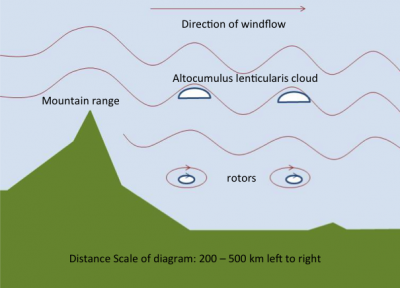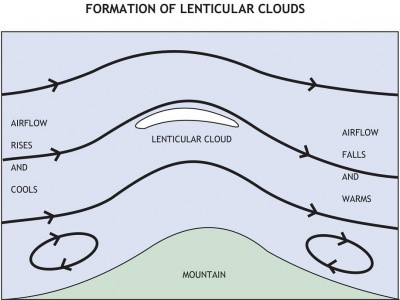Mountain Waves
Definition
Mountain Waves is defined as oscillations to the lee side (downwind) of high ground resulting from the disturbance in the horizontal air flow caused by the high ground.
Description
The wavelength and amplitude of the oscillations depends on many factors including the height of the high ground relative to surrounding terrain, the wind speed and the instability of the atmosphere.
Formation of mountain waves can occur in the following conditions:
- Wind direction within 30 degrees of the perpendicular to the ridge of high ground and no change in direction over a significant height band.
- Wind speeds at the crest of the ridge in excess of 15 kts, increasing with height.
- Stable air above the crest of the ridge with less stable air above and a stable layer below the ridge.

Mountain waves
Vertical currents within the oscillations can reach 2,000 ft/min. The combination of these strong vertical currents and surface friction may cause rotors [1] to form beneath the mountain waves causing severe turbulence.
Effects
Mountain Waves are associated with severe turbulence, strong vertical currents, and icing.
- Loss of Control and / or Level Bust. The vertical currents in the waves can make it difficult for an aircraft to maintain en route altitude leading to level busts and can cause significant fluctuations in airspeed potentially leading, in extreme, to loss of control.
- Loss of Control can also occur near to the ground prior to landing or after takeoff with a risk of terrain contact or a hard landing if crew corrective response to a downdraft is not prompt.
- Aircraft can suffer structural damage as a result of encountering severe clear air turbulence.
- In extreme cases this can lead to the breakup of the aircraft.
- In even moderate turbulence, damage can occur to fittings within the aircraft especially as a result of collision with unrestrained items of cargo or passenger luggage. If caught unaware, passengers and crew walking around the aircraft cabin can be injured.
- Severe icing can be experienced within the clouds associated with the wave peaks.
Defenses

Lenticular Clouds (lens shaped clouds)
-
- When approaching a mountain ridge, it is advantageous, if heading upwind towards it, to cross at an angle of around 30 – 45 degrees in order to allow an escape should downdrafts prove excessive.
- In the Alps regions, particularly in the Zurich – Milano regions, a general rule of thumb that a QNH difference of more than 5 – 8 mb between LSZH and LIMC, for example, or between north and south of the Alps, will provide for significant mountain wave activity over the Alps. A higher QNH in Zurich will result in mountain waves south of the Alps, for example.
- If significant mountain wave activity is expected, as a rule of thumb and if possible plan a flight at least 5000 – 8000 feet above the highest elevation along your route.
- Local knowledge of the conditions which tend to cause the formation of mountain waves enables forecasting of potential wave propagation.
- Cloud Formation.Lenticular Clouds (lens shaped clouds) can form in the crest of the mountain waves if the air is moist.
- Roll Clouds can also occur in the rotors below the waves if the air is moist. These clouds are a good indication of the presence of mountain waves but, if the air is dry, there may not be any cloud to see.
Windward of the mountains IMC conditions may likely be present, whereas due to the “Foehn Effect” VMC conditions are generally expected to the leeward.
- Restraint Systems. Passengers and flight crew should routinely wear their seat belts / harnesses when seated to provide protection against unexpected turbulence.
Scenarios
An aircraft tracking perpendicularly across, or downwind of, a mountain range or a significant mountain ridge experiences a sudden loss of altitude followed by a significant and sudden reduction in airspeed during severe turbulence. Regaining the desired flght path may be difficult, for a relatively short period, until the wave is exited.
Solutions
- Reducing the aircraft speed reduces the risk of structural damage and reduces vibration making instruments easier to read in turbulence BUT beware the effect of vertical currents on airspeed and the risk of stalling the aircraft.
- Strap in.Aircraft commanders should ensure that if conditions in which there is a possibility of encountering mountain wave turbulence are envisaged en route that not only are seat belt signs selected on but that all cabin crew are instructed to cease service and secure their equipment and themselves in good time.
- Inform ATC.Notify ATC of mountain wave activity.

Write a Comment